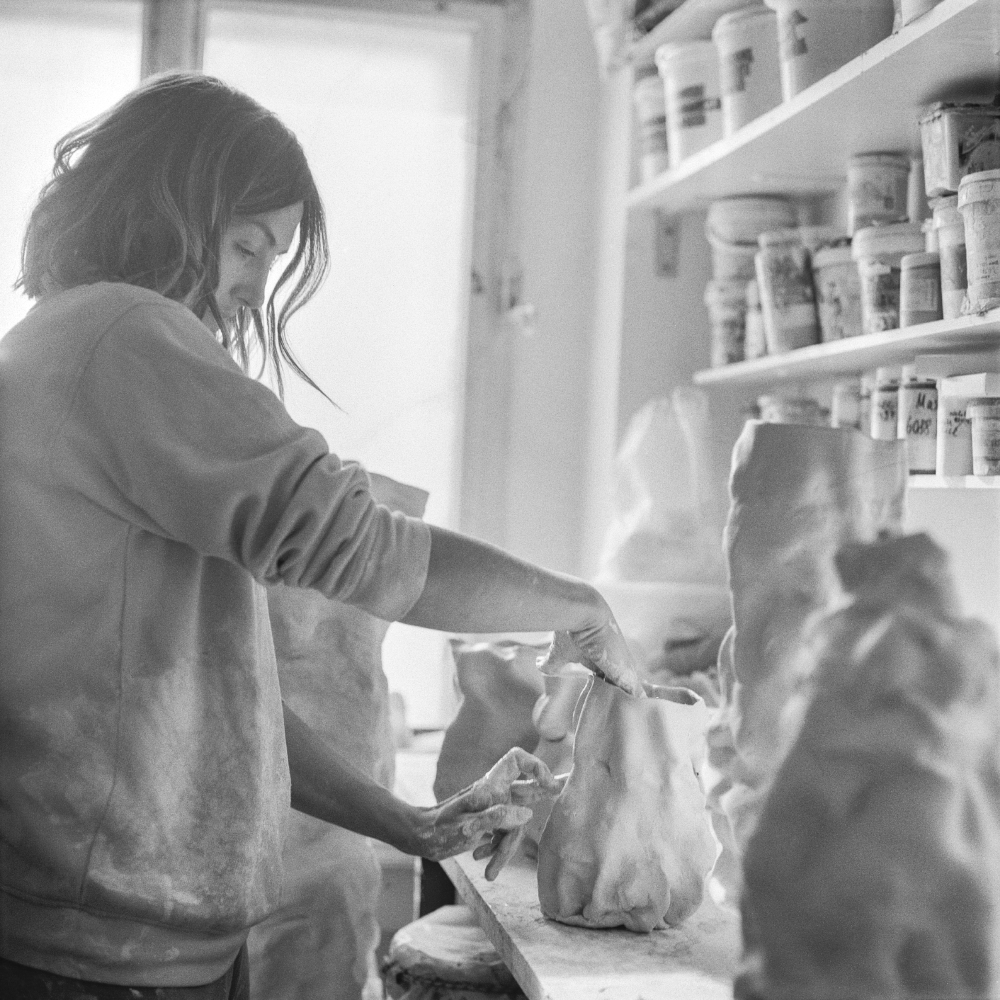By Victoria Anastasyadis
To Sarah Pschorn (b. 1989), her solo exhibition ‘Records of Gravity’, held at Gerhard Marcks Haus in Bremen in early 2023, is not so much a look back as a look forward. Despite her years of experience working with clay, she feels she is still a novice. This is a portrait of a young sculptor and her art.
For a long time, she did not feel comfortable being called a ‘sculptor’. You tend to associate that with removing material, such as stone or wood, rather than constructing something with clay. At first, she was often called a designer but she’s certainly not that. She makes sculptures. Not always using ceramics only; random objects she has found and other materials such as metal and glass also often find their way into her work. She has her own practice and is part of a whole movement of contemporary (female) sculptors who work with clay, which also includes Nicole Cherubini (US), Elsa Sahal (FR) and Virginia Leonard (NZ). Pschorn’s work is noticed and praised: at the 62nd edition of the Faenza Biennale, one of the world’s most important events for contemporary ceramic art, for example, she was awarded the Monica Biserni Prize (fig. 2).
Sarah Pschorn was born in Dresden, a city that was destroyed in World War II and, to this day, is still being restored to its former, baroque glory. The lavish Meissen porcelain from that stylistic period – especially the porcelain designed under the supervision of sculptor Johann Joachim Kändler (1706-1775) – inspired her graduation work. Pschorn was very familiar with clay long before she entered professional ceramics training. As a five-year old girl, she accompanied her mother to a pottery course. She found it boring at first, possibly because there were so many adults and because she had to be quiet. At some point, however, she discovered the great potential of clay: you can build anything you want with it. She continued classes until she was eighteen, and was fortunate enough to meet teacher Sonja Puppe who encouraged her to experiment. Pschorn taught herself throwing. When, at the age of eight, she wanted her own potter’s wheel, her mother made her choose between a summer holiday or a potter’s wheel. She chose the latter and set up a workplace on the balcony of their rented flat in Dresden. When her teacher Puppe was unable to work due to illness Pschorn, as her longest-serving student, took over the lessons for a while. She was just 16 years old. Puppe also invited befriended artists and ceramists to teach guest lessons. Nevertheless, Pschorn could not yet envisage a profitable, full-time career in ceramics.


That changed when she started volunteering at the Řehlovice cultural centre in the Czech Republic, run by ceramic designer Lenka Holíková. There, for the first time, she saw how artists work and what her daily life could also be like. She created some clay pieces and even had a small exhibition with an accompanying catalogue. Opting to become an artist was still too great a step, however. After secondary school, she worked at a Montessori school in the south of France. She had decided to become an art teacher, even though she secretly knew that she wouldn’t really enjoy that enough. This was also evident to the Admissions Committee of the Burg Giebichenstein Art Academy in Halle, where she applied for the Art Education course, and she was not accepted. The head of the ceramics department, Prof. Martin Neubert was nonetheless enthusiastic about her portfolio and advised her to gain another year’s experience of life and then come back. Which she did.
During that year, she worked for a traditional pottery in Dresden that used wood-fired kilns. It was an unpaid, and by no means easy apprenticeship, working from 7 a.m. and throwing some 50 items a day. There was little room for experimentation and imagination, the focus here was on the craft of consistently recreating familiar household objects. She learned a lot, especially that this was not for her.
The day finally came that she could start art school. Accustomed to starting work early, Pschorn reported at 8 a.m. but there was no one there. It was not until ten o’clock that – to her surprise and relief – the school came alive. Burg Giebichenstein (‘die Burg’) is a renowned art school that had close ties to the Bauhaus. In 1925, ‘Formmeister’ Gerhard Marcks and his students Marguerite Friedlaender and Franz Wildenhain made the move from Germany’s most famous design school to Halle, where they shaped the sculpture and ceramics workshops with their modern views.1 Their influence remains evident in the training programme to this day. While Pschorn focused on ceramics within the sculpture department, she also ventured into other departments, especially photography. She was surprised at how well art suited her.
In the third year, art history classes covered the Baroque period and she became interested in early Meissen porcelain. Items she created for her graduation series ‘Copy and Paste’ included large, porcelain pots, clearly inspired by the past, combined with other materials such as found glass goblets and experimental surface treatments (fig. 3). She calls them three-dimensional collages. Taking an interest in the zeitgeist, she also applied modern techniques, scanning and digitally deforming shapes before printing them with a 3D printer. Thus making her work more abstract (fig. 4).

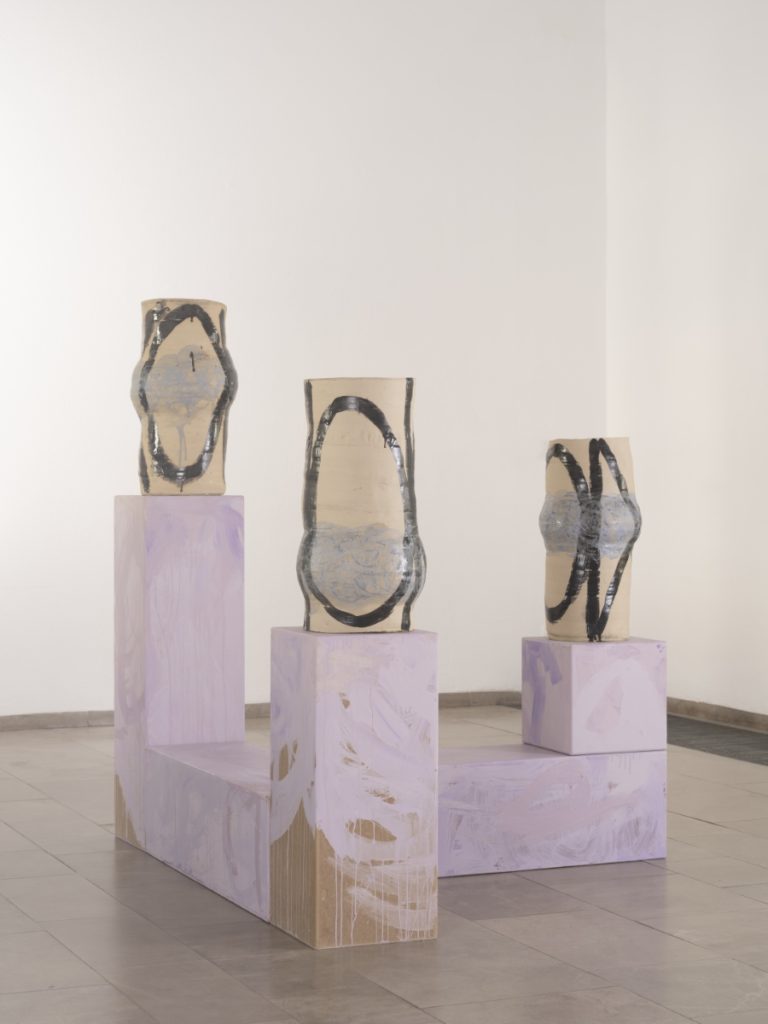

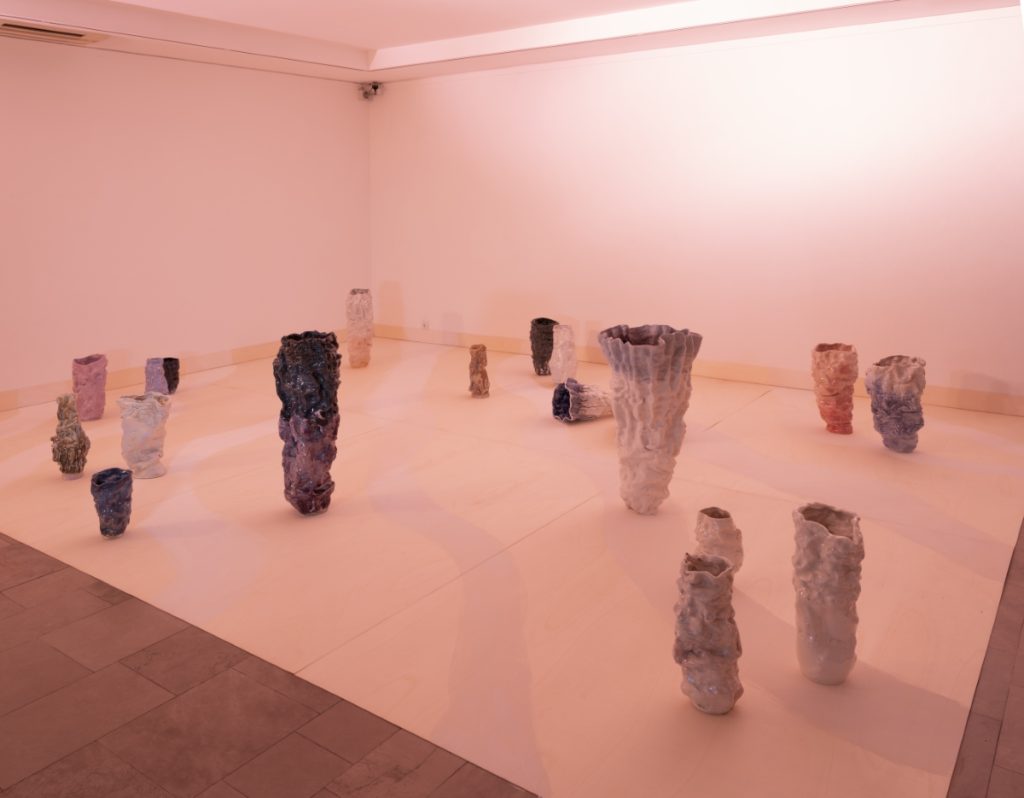
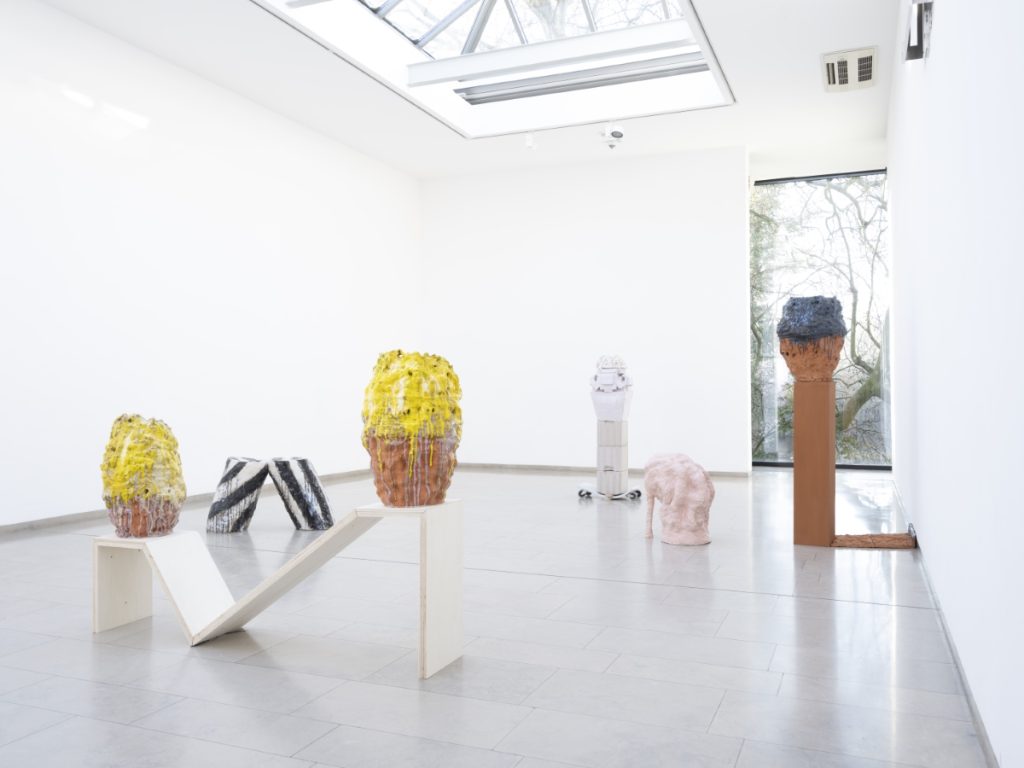
Even during her studies, Sarah Pschorn frequently exhibited her work. It was almost as if her graduation was just a part-time job, she jokes. She also regularly entered competitions and these activities helped her to set up a professional practice once she had completed her studies. After graduating, in 2015, she moved to Leipzig. Whereas ten years earlier, Berlin had been the place to be for ‘die Burg’ graduates, it was now Leipzig. Not that Halle was not a nice place to live. Indeed, for many it was a case of: I don’t want to stay here, but I have no reason to leave. She moved into a small studio in an old factory and managed to obtain a second-hand kiln. A grant for new graduates enabled her to start making large pieces again. She occasionally also worked elsewhere through residencies, including one in Japan.
Which brings us to Sarah Pschorn’s first major solo museum exhibition. The idea for that arose in 2020 when she was working with B14 Gerhard Marcks Künstlerhaus in Ahrenshoop. The Gerhard Marcks Haus sculpture museum in Bremen, which has close ties with the residency venue, decided to financially support the young artist, enabling her to create new work, and offered her an exhibition; an admirable patronage to keep sculpture thriving.
Her earliest work at the exhibition dated from 2018 (fig. 5). The deconstructed shapes from her graduation series reverberated in ‘Pushing each other further 2’ but her work later became increasingly organic and pictorial. A development she attributes to the time she spent on her allotment and her growing connection with nature, which she incorporates into her sculptures. With its upward ‘thrust’, the ‘Cloudy’ series (fig. 6) clearly reflects a connection with nature. The lighting installation, which very gradually changes the colour of the room from bright daylight to a dusky pink, enhances the feeling of looking at something that is developing, growing, and blossoming (fig. 7).
Other work reflects a certain humour, such as the ‘Balance’ series (fig. 8), each of which reflects a different perception of balance. From a slouching standing leg and pillars propping each other up to a sculpture wobbling on a collapsed ‘dolly’ (a small platform on wheels, often used to move museum pieces). The ’Heaviness’ series includes towel sculptures, created by dipping towels in liquid clay and then firing them, which burns the textiles but preserves the texture. (fig. 9 and 10).
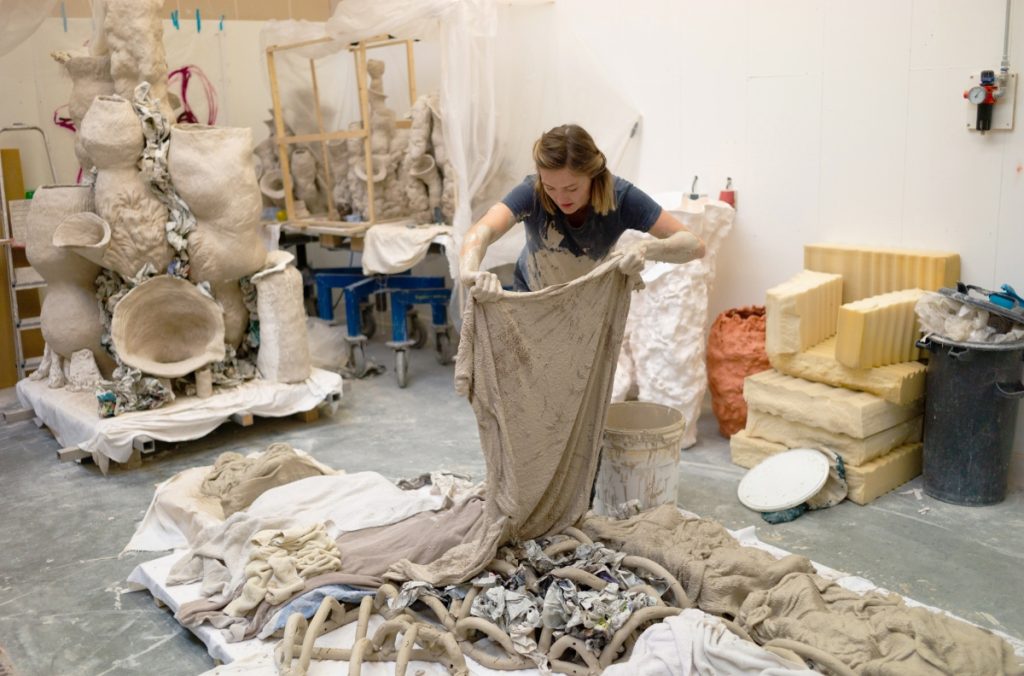
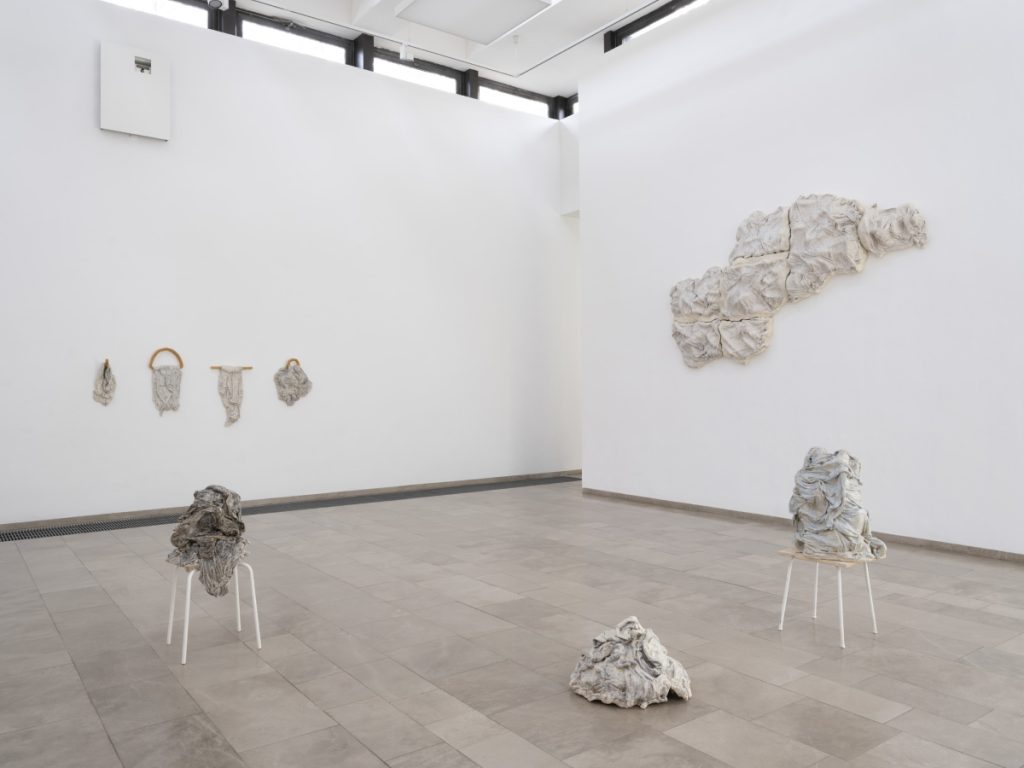
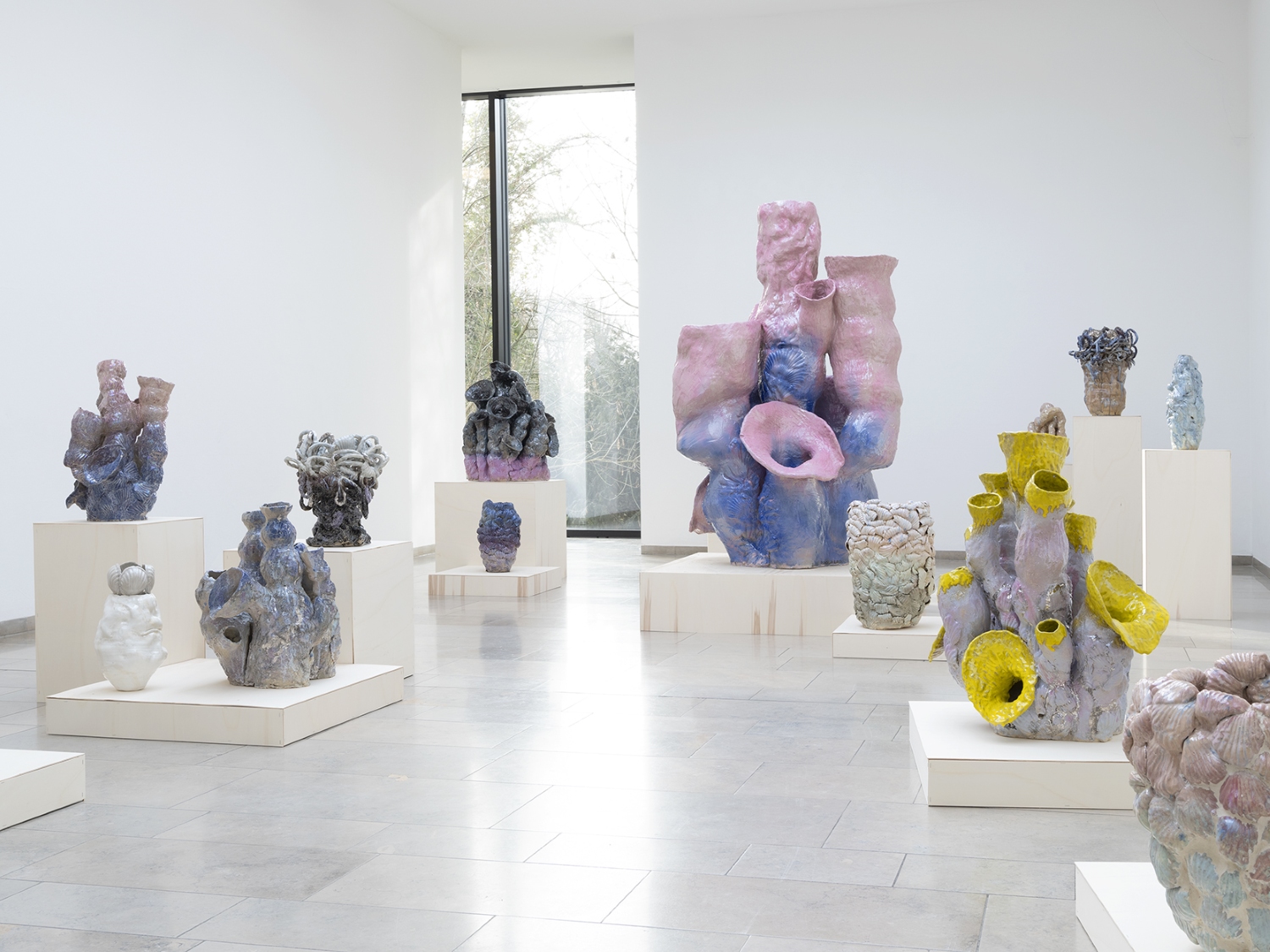

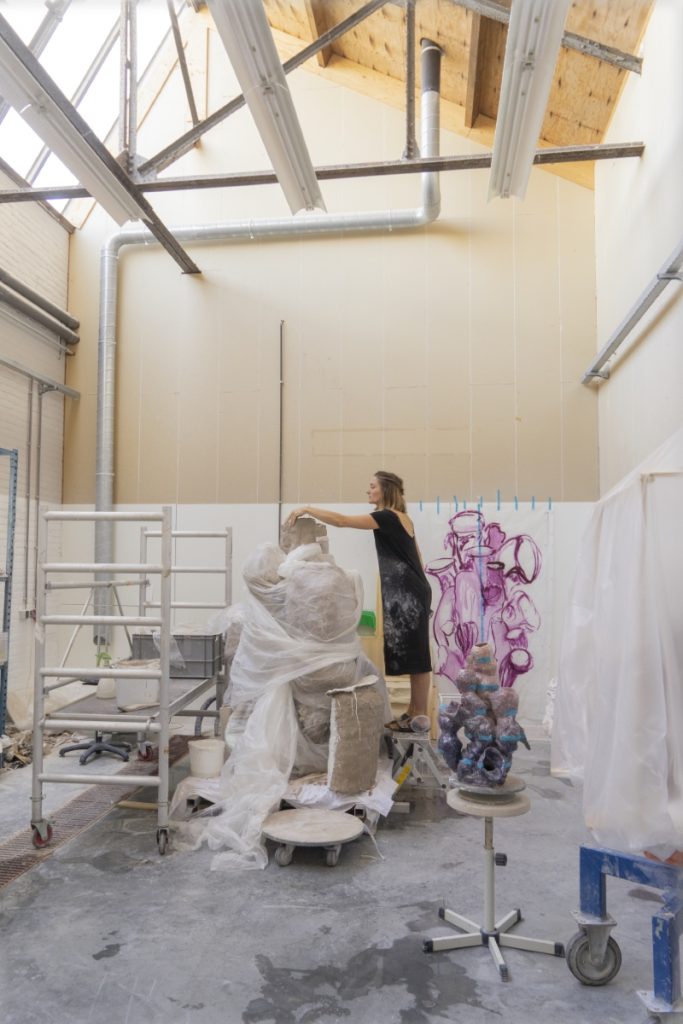
The highlight of the exhibition is ‘Paradise’ (fig. 11). As a child, Pschorn was convinced that she was destined to live underwater; she had even told her mother of their inevitably impending parting. Now she has created for herself a wonderful underwater world in which sculptures made from shells rise up like corals on their pedestals. She produced some of these works, including the immense eye-catcher ‘Deep Blue Sea’ (2022), at EKWC, the ‘international artist-in-residence and centre of excellence for ceramics’ in Oisterwijk, the Netherlands (fig. 13). She worked there for three months, where she was able to use the large kilns and draw on the existing expertise in making such complex works. She used a massive five hundred kilos of clay in this one sculpture, a physically highly demanding task. Glazing the work from blue to pink and applying iridescent lustre was done in several firing rounds. It was a nail-biting moment each time the kiln opened: did it go well?
Clearly it did, yet the fact that she succeeded does not mean that she has finished with clay. On the contrary, Sarah Pschorn sees herself continuing each of the themes of the exhibition (Balance, Heaviness, Cloudy, Paradise) for a long time to come. As in a book, where each chapter could have been a whole novel in itself. When you work with a particular material or technique for a very long time something interesting happens, Pschorn feels. She accepts that phases of boredom and resistance have to be endured to be overcome. Just like in a relationship, as a deeper understanding gradually develops. Only then does quality emerge. And genuine love.
The exhibition was accompanied by the catalogue Sarah Pschorn – Records of Gravity, edited by Bettina Berg, Mirjam Verhey-Focke and Veronika Wiegartz, 64 pages, ISBN 9783948914127
This article by Victoria Anastasyadis is a specially updated and translated version for Ceramics Now of a text that previously appeared in Vormen uit Vuur 252 (2023/2). ‘Vormen uit Vuur’ is a Dutch academic journal on glass and ceramics, published since 1952 by the Nederlandse Vereniging van Vrienden van Ceramiek en Glas. The journal appears in print and includes English summaries.
Visit Sarah Pschorn’s website and Instagram page.
Translation by Melanie Niesink.
Captions
- fig 1. Sarah Pschorn in her Studio in Leipzig, 2022, photo Jakob Adolphi
- fig 2. Various works, awarded with the Monika Biserni Prize, 2020, porcelain, clay, platinum, glaze, lustre, found objects (glass and metal), heights 34-66 cm., photo Jakob Adolphi
- fig 3.’Material Girl I’ series, 2015, porcelain, clay, glass, silicone, nail polish, found objects, platinum, aluminium foil and epoxy, photo Jakob Adolphi
- fig 4. ‘Styrocut #1’, 2015, porcelain, photo Jakob Adolphi
- fig 5. ‘Pushing each other further 2’, 2018-2023, clay, glaze, wood, lacquer, photo Rüdiger Lubricht
- fig 6. ‘Cloudy 30’, 2022, porcelain, glaze, lustre, 95 x 50 x 45 cm., photo Jakob Adolphi
- fig 7. Gallery view of exhibition ‘Records of Gravity’ – ‘Cloudy’, 2020-2023, porcelain, glaze, platinum, chandelier, Gerhard-Marcks-Haus, Bremen (DE), 2023, photo Rüdiger Lubricht
- fig 8. Gallery view of exhibition ‘Records of Gravity’ – ‘Balance’, Gerhard-Marcks-Haus, Bremen (DE), 2023, photo Rüdiger Lubricht
- fig 9. Sarah Pschorn in her Studio at EKWC working on the ‘Towel sculptures’, 2022, photo Erik Benjamins
- fig 10. Gallery view of exhibition ‘Records of Gravity’ – ‘Schwere’ (Heaviness), 2023, Gerhard-Marcks-Haus, Bremen (DE), photo Ruediger Lubricht
- fig 11. Gallery view of exhibition ‘Records of Gravity’ – ‘Paradies’ (Paradise), Gerhard- Marcks-Haus, Bremen (DE), 2023, photo Rüdiger Lubricht
- fig 12. Detail of ‘Pirates Gospel 1’, 2021, clay, glaze, platinum and lustre, photo Jakob Adolphi
- fig 13. Sarah Pschorn working on ‘Deep Blue Sea’ at the European Ceramic Work Centre (EKWC), Oisterwijk, 2022, photo Sarah Pschorn
Footnotes
- For more on the history of these design schools and the exchange with the Netherlands, see M. Simon Thomas, ‘Burg Giebichenstein in Halle – Van het Bauhaus via de Burg naar Nederland’, in: Nederland – Bauhaus. Pioniers van een nieuwe wereld, Rotterdam (Museum Boijmans Van Beuningen) 2019, pp. 92-100 and A.H. de Jong, ‘Van Bauhaus tot Pond Farm – Marguerite Friedlaender (1896-1985)’, Vormen uit Vuur 239 (2019-1), pp. 4-25.


